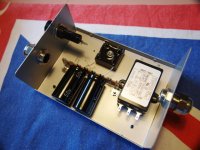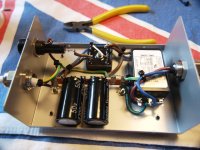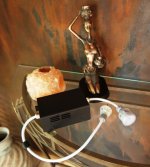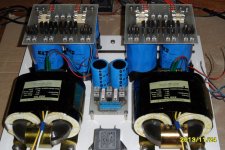Possibly not strictly a PS but more about getting clean power I decided to try a DC blocker. Australia at one time had the cleanest power but since the grid has been privatized power quality has fallen. A DIY friend built a simple blocker and claimed he felt an improvement in sound quality. Because he has tube monoblocks he built two and believed a better improvement again. Also any DC on the mains will generally cause most big toroids to buzz. He had had a lot of problems with this.
Because the project is so inexpensive I decided to build one based on the Recommend Design from this link. Look toward the end of the article. To value add a little I included a cheap RFI\EMI filter in the one compact enclosure. For the last few years all my power amps have a power filter built in but not my media players or preamps. Now they have better cleaner power.
I wanted to source all components from where I worked but could only find 4700uf caps at 50V. My bridge rec. is rated 35A. Since the caps should never seed any more than a few volts this should not be a problem. I added a choke to the lead in and a 10A easy access slow blow fuse to the build.
On a short listen through my all tube system, apart from a better defined sound stage, I can hear no HUGE improvement. A more extended listen may reveal other improvements. But now I know that my gear is a no-go zone for DC and all equipment is receiving filtered power. I built this up from scratch and had it working in a short afternoon for a total cost of $35. There is no reason not to have one.
Because the project is so inexpensive I decided to build one based on the Recommend Design from this link. Look toward the end of the article. To value add a little I included a cheap RFI\EMI filter in the one compact enclosure. For the last few years all my power amps have a power filter built in but not my media players or preamps. Now they have better cleaner power.
I wanted to source all components from where I worked but could only find 4700uf caps at 50V. My bridge rec. is rated 35A. Since the caps should never seed any more than a few volts this should not be a problem. I added a choke to the lead in and a 10A easy access slow blow fuse to the build.
On a short listen through my all tube system, apart from a better defined sound stage, I can hear no HUGE improvement. A more extended listen may reveal other improvements. But now I know that my gear is a no-go zone for DC and all equipment is receiving filtered power. I built this up from scratch and had it working in a short afternoon for a total cost of $35. There is no reason not to have one.
Attachments
Last edited:
None of my gear runs GNFB. If you read the article you will see that you only need a few mA of current to cause big problems with large toroids. DC can be caused by industrial equipment, like where my DIY friend lives, or simple devices in the home. The way mains power is managed, by default, puts DC on the grid.
EI trannies handle small amounts of DC current better but still cause partial saturation. Some of the trannies in my tube amps run hot. My 300B draws 200mA at 435V and though the tranni is massive it gets very hot. I am yet to check this amp with the blocker but hopefully there is an improvement. I know with Halcro FET amps ($40K a pair) half the amp is just power conditioning. If you don't start with clean power you will never get a clean sound.
EI trannies handle small amounts of DC current better but still cause partial saturation. Some of the trannies in my tube amps run hot. My 300B draws 200mA at 435V and though the tranni is massive it gets very hot. I am yet to check this amp with the blocker but hopefully there is an improvement. I know with Halcro FET amps ($40K a pair) half the amp is just power conditioning. If you don't start with clean power you will never get a clean sound.
Only very big toroids (500V plus) have big problems. There is a lot of RFI\EMI on mains. A lot of this will pass right through even a good PS. I noticed from my very first amp I incorporated power filters my power amps sound better, clearer. I haven't built a power amp in years that doesn't have it's own power filter. I often get comments about how clear my tube amps sound. This year alone I made four tube power amps for myself which all sold in a week. I had no intention of selling them but others liked them so much I had to let them go. I'm not saying it is solely because of the power filters but I think they have a part in it.
It seems to me that you could install MOV surge supressors inside that cabinet, upstream of the EMI filter. I recall a delightful article in the #2/1991 issue of The Audio Amateur, "About Noise" by L. B. Dalzell, which included this section on page 12:
An Audio Placebo
In medical research, when a new drug is tested on humans, who are subject to the power of suggestion, the researcher uses a placebo, an innocuous pill or capsule, and compares the results of the test group and the placebo group.
I strongly believe in the value of what I shall call an "audio placebo". I constructed four different AC filters for testing: (A) consisted only of the MOV device; (B) contained only a commercial RFI filter; (C) used a commercial RFI filter and the MOV devices; (D) was the placebo (it was wired straight through).
I used three MOVs in each of (A) and (C) just to be sure. One MOV was wired from the line to the neutral, one from the line to ground, and the last from the neutral to ground.
The four AC filters were given to audio enthusiasts for trial and were sealed in cast boxes to prevent peeking.
The resulting ratings in use, when participants were asked: choose the best of the four, were
- A. 13% (only MOV)
- B. 25% (only RFI filter)
- C. 60% (both)
- D. 2% (placebo - neither)
DC on the mains
If you want to make a circuit for keeping mains away from the primary of the transformer please have a look in Bob Cordells excellent book "Designing Audio Power Amplifiers". The circuit can be found on page 360 and can be made from few relatively inexpensive components.
Karsten
If you want to make a circuit for keeping mains away from the primary of the transformer please have a look in Bob Cordells excellent book "Designing Audio Power Amplifiers". The circuit can be found on page 360 and can be made from few relatively inexpensive components.
Karsten
I to have build the DC-blocker from Rod Elliot.
See the small PCB in the middle, on this PCB are also 2 safety loop breakers installed.
After reading on ESP what a huge effect even a small DC-current has on the transformer capability, it has to be there in my next design.
I'm using 63V/10000µf caps from BC Components/Vishay, rated with a ripple current at 100Hz of 5.4A. The diodes are 15A/600V devices.
See the small PCB in the middle, on this PCB are also 2 safety loop breakers installed.
After reading on ESP what a huge effect even a small DC-current has on the transformer capability, it has to be there in my next design.
I'm using 63V/10000µf caps from BC Components/Vishay, rated with a ripple current at 100Hz of 5.4A. The diodes are 15A/600V devices.
Attachments
This shows that a filter and protective gear actually produces better sound.It seems to me that you could install MOV surge supressors inside that cabinet, upstream of the EMI filter. I recall a delightful article in the #2/1991 issue of The Audio Amateur, "About Noise" by L. B. Dalzell, which included this section on page 12:
I to have build the DC-blocker from Rod Elliot.
See the small PCB in the middle, on this PCB are also 2 safety loop breakers installed.
After reading on ESP what a huge effect even a small DC-current has on the transformer capability, it has to be there in my next design.
I'm using 63V/10000µf caps from BC Components/Vishay, rated with a ripple current at 100Hz of 5.4A. The diodes are 15A/600V devices.
I thought about including blockers in amps but I already include power filters in all power amps. At this point I will keep external a single shared blocker. After further listening I get the feeling the soundstage definition has improved which is the same remark a friend made who got me into them.
This shows that a filter and protective gear actually produces better sound.
It is anecdotal data. That particular set of listeners, when presented with that particular set of power line filters, expressed a strong preference for the sound when their music equipment was plugged into filter C (RFI filter plus 3 MOVs). A surprising and delightful little piece of information.
But as George Carlin famously said about a ruling by the United States Supreme Court, "That's their opinion." Yours may differ.
This shows that a filter and protective gear actually produces better sound.
In most cases EMI filters produce inferior sound to my ears.
As for dc filtering - it definitely changes the sound. Not too sure the change is an improvement though.
Of course, if significant dc is actually present, such a filter becomes essential.
A friend paid $5K for a huge audiophile strength mains filter and said it buggered the sound. He sold it and bought some solid core mains leads for all of his gear and claimed he got a huge improvement for less than half the price.In most cases EMI filters produce inferior sound to my ears.
As for dc filtering - it definitely changes the sound. Not too sure the change is an improvement though.
Of course, if significant dc is actually present, such a filter becomes essential.
How about a sanity check here.
Elliott's article discusses transient or short duration effects, not continuous noise - are those people putting that gear in hearing no noise only now in their noise floor during quiet sections between music tracks - is that the tangible benefit? Or are they now not hearing mechanical noise from their power transformer(s) - again that would be a tangible observation during a quiet noise floor. To say that they hear a benefit during music sessions sounds pretty much a red herring/placebo effect.
I'd suggest that there is no electrical influence of such mains dc disturbances within the amplifier itself, unless the amp was initially so badly designed that it let almost any type of external disturbance affect it, or let mechanical transformer vibration somehow transfer in to an electrical noise.
Elliott's article discusses transient or short duration effects, not continuous noise - are those people putting that gear in hearing no noise only now in their noise floor during quiet sections between music tracks - is that the tangible benefit? Or are they now not hearing mechanical noise from their power transformer(s) - again that would be a tangible observation during a quiet noise floor. To say that they hear a benefit during music sessions sounds pretty much a red herring/placebo effect.
I'd suggest that there is no electrical influence of such mains dc disturbances within the amplifier itself, unless the amp was initially so badly designed that it let almost any type of external disturbance affect it, or let mechanical transformer vibration somehow transfer in to an electrical noise.
A friend paid $5K for a huge audiophile strength mains filter and said it buggered the sound. He sold it and bought some solid core mains leads for all of his gear and claimed he got a huge improvement for less than half the price.
I could easily have been that friend had i bought a 5k mains filter
Currently my entire system is wired with a mix of solid core OCC Neotech. Only the dac has a screened Furutech pc.
$50 for an ordinary 'strength' mains filter might have been all that was necessary. You should get a lot of 'stuff' for $5k so if poorly designed I suppose it could make a lot of difference. Alternatively, it could be that the filter worked fine but your friend prefers his sound with added interference - there is some anecdotal evidence for this.mhouston said:A friend paid $5K for a huge audiophile strength mains filter and said it buggered the sound.
You'll need only 10 or 16 Volts caps since you have only 1-2 volts across them. It's also better to have more capacitance because the filter will be more effective.I wanted to source all components from where I worked but could only find 4700uf caps at 50V.
The DC creates only a mechanical sound in the transformer itself. This hum can be really annoying in a quiet room.Unless the DC is bad I cant imagine getting a much improved sound.
You'll need only 10 or 16 Volts caps since you have only 1-2 volts across them. It's also better to have more capacitance because the filter will be more effective.
You are absolutely correct concerning the voltage, but all lower voltage caps I have found are all having a rather low ripple current.
I have selected my caps to have an available ripple current higher than the maximum primairy current with maximum loaded transformer.
==> 2X500VA R-core on 240Vmains 50Hz ==> ripple current >4.16
==> caps are 10000µf/63V with a ripple current of 5.4A at 50Hz.
- Status
- This old topic is closed. If you want to reopen this topic, contact a moderator using the "Report Post" button.
- Home
- Amplifiers
- Power Supplies
- DC blockers and mains filters



